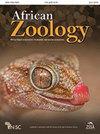沼泽Mongoose在非永久性水库周围的饮食:一位通才机会主义者对螃蟹缺席的回应
IF 0.5
4区 生物学
Q4 ZOOLOGY
引用次数: 3
摘要
沼泽猫鼬或水猫鼬的饮食已经在沿海和内陆河流栖息地进行了很好的研究,螃蟹通常是发生频率的主要猎物。我们调查了生活在小型非永久性水库(Andries Vosloo Kudu自然保护区,东开普省)附近的少量沼泽猫鼬的摄食生态,那里没有淡水螃蟹。通过对2006-2009年收集的133种粪便的发生率和食物残留体积百分比的综合度量,没有发现主要猎物。两栖动物、哺乳动物、节肢动物和鱼类都是次要猎物。植物补充了他们的饮食,而鸟类只作为微量食物出现。食性有季节性变化,以两栖类(春季)、节肢动物(夏季)和鱼类(秋季)为食性高峰。全年日粮多样性和生态位宽度较高。这项研究有力地表明,沼泽猫鼬实际上是一种多面手的机会主义者。虽然它在螃蟹和其他水生猎物特别丰富的地区捕食螃蟹和其他水生猎物,但它可以适应当地的食物供应,并在其饮食中包括相当大比例的陆地猎物。本文章由计算机程序翻译,如有差异,请以英文原文为准。
Diet of the Marsh Mongoose around a Non-Permanent Reservoir: Response of a Generalist Opportunist Forager to the Absence of Crabs
The diet of the marsh or water mongoose Atilax paludinosus has been well studied in coastal and inland riverine habitats, where crabs often constitute the main prey in terms of frequency of occurrence. We investigated the feeding ecology of a small number of marsh mongooses living next to a small, non-permanent reservoir (Andries Vosloo Kudu Nature Reserve, Eastern Cape), where freshwater crabs were not available. Using a combined metric of the percentage of occurrence and the percentage volume of food remains in 133 scats collected from 2006–2009, no primary prey could be detected. Amphibians, mammals, arthropods and fish all acted as secondary prey. Plants supplemented the diet, whereas birds only occurred as trace foods. There were seasonal variations in the diet, with peaks in amphibian (spring), arthropod (summer) and fish (autumn) consumption contributing to the change. Dietary diversity and niche breadth were relatively high throughout the year. This study strongly suggests that the marsh mongoose is in fact a generalist opportunist feeder. Although it consumes crabs and other aquatic prey in areas where they are particularly abundant, it can adapt to local food availability and include a significant proportion of terrestrial prey in its diet.
求助全文
通过发布文献求助,成功后即可免费获取论文全文。
去求助
来源期刊

African Zoology
生物-动物学
CiteScore
2.60
自引率
9.10%
发文量
18
审稿时长
>12 weeks
期刊介绍:
African Zoology , a peer-reviewed research journal, publishes original scientific contributions and critical reviews that focus principally on African fauna in terrestrial, freshwater, and marine ecosystems. Research from other regions that advances practical and theoretical aspects of zoology will be considered. Rigorous question-driven research in all aspects of zoology will take precedence over descriptive research. The Journal publishes full-length papers, critical reviews, short communications, letters to the editors as well as book reviews. Contributions based on purely observational, descriptive or anecdotal data will not be considered.
The Journal is produced by NISC in association with the Zoological Society of South Africa (ZSSA). Acceptance of papers is the responsibility of the Editors-in-Chief in consultation with the Editors and members of the Editorial Advisory Board. All views expressed are those of the author and not necessarily those of the Editors or the Department.
 求助内容:
求助内容: 应助结果提醒方式:
应助结果提醒方式:


